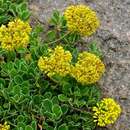en
names in breadcrumbs


In the following key and descriptions, reference is made to “glabrous” leaf surfaces. This is a function of both age and power of observation. High-power magnification may show some exceedingly fine hairs that are not readily observable to the naked eye. Furthermore, new leaves that ultimately will be “glabrous” will have some fine-tomentose pubescence that becomes less obvious (or even wholly inconspicuous) as the blade expands and matures. Here, the term “glabrous” is used to refer to leaves that are not obviously hairy and are typically bright green on both surfaces when the plant is at full anthesis.
There are several reported uses of sulphur flower in the enthobotany literature, mostly without an indication of the variety. J. B. Romero (1954) indicated that in California, where most of the variants are found, an infusion of the flowers is used for ptomaine poisoning, and M. L. Zigmond (1981) stated that the Kawaiisu used mashed flowers as a salve for gonorrheal sores. E. V. A. Murphey (1959), who worked with P. Train et al. (1941), reported that in Nevada members of the species (most likely var. nevadense) were used in the treatment of colds and stomachaches; J. H. Steward (1933) reported the same uses among the Owens Valley Piute in California. Train and his group noted that poultices of leaves and sometimes roots were used for lameness or rheumatism. In Oregon, leaves of var. ellipticum were used in a poultice to soothe pain, especially that resulting from burns (F. V. Coville 1897; L. Spier 1930). Most of the reports associated with the Navajo or Diné people probably relate to the use of var. subaridum. L. C. Wyman and S. K. Harris (1951) found the species used as a disinfectant or an emetic. The Cheyenne people employed a mixture of powdered stems and flowers to halt lengthy menses (G. B. Grinnell 1923; J. A. Hart 1981). According to A. Johnston (1987), the Blackfoot made a tea from boiled leaves.
The cythera metalmark butterfly (Apodemia mormo cythera) is found in association with a few varieties of sulphur flower (G. F. Pratt and G. R. Ballmer 1991). More commonly seen with the species are the Rocky Mountain dotted-blue (Euphilotes ancilla) and lupine blue (Plebeius lupini).
Eriogonum umbellatum is a species of wild buckwheat known by the common name sulphurflower buckwheat, or simply sulphur flower. It is native to western North America from California to Colorado to central Canada, where it is abundant and found in many habitats, including the sagebrush steppe and alpine areas.[1] It is an extremely variable plant and hard to identify because individuals can look very different from one another. Also, there are many varieties. It may be a perennial herb blooming by summer[1] with stems 10 centimeters tall and two to six clusters of flowers, with a whorl of leaves below the stems,[1] or a sprawling shrub approaching two meters high and wide. The leaves are usually woolly and low on the plant, and the flowers come in many colors from white to bright yellow to purple.
It is a popular larval host, feeding the bramble hairstreak, desert green hairstreak, lupine blue, Mormon metalmark, Rocky Mountain dotted blue, Sheridan's hairstreak, Sonoran metalmark, and western green hairstreak.[2] Additionally, goats and domestic sheep feed on the plant.[3]
Varieties of this species include, but are not limited to:
The wildflower gardening author Claude A. Barr complemented sulphurflower buckwheat as a "treasure in appearance and in adaptation in my garden."[4] It is valued for its very low water usage for xeriscaping. The cultivar "Kannah Creek", a selection of Eriogonum umbellatum var. aureum, has been introduced to the garden trade by the Plant Select cooperative sponsored by Colorado State University and Denver Botanic Gardens.[5][6] It grows in USDA zones 4–8.[7]
E. umbellatum var. hypoleium (habit, William O. Douglas Wilderness)
E. umbellatum var. majus (flowers, Wenatchee Mountains)
E. umbellatum var. subaridum (flowers, Spring Mountains)
Eriogonum umbellatum is a species of wild buckwheat known by the common name sulphurflower buckwheat, or simply sulphur flower. It is native to western North America from California to Colorado to central Canada, where it is abundant and found in many habitats, including the sagebrush steppe and alpine areas. It is an extremely variable plant and hard to identify because individuals can look very different from one another. Also, there are many varieties. It may be a perennial herb blooming by summer with stems 10 centimeters tall and two to six clusters of flowers, with a whorl of leaves below the stems, or a sprawling shrub approaching two meters high and wide. The leaves are usually woolly and low on the plant, and the flowers come in many colors from white to bright yellow to purple.
It is a popular larval host, feeding the bramble hairstreak, desert green hairstreak, lupine blue, Mormon metalmark, Rocky Mountain dotted blue, Sheridan's hairstreak, Sonoran metalmark, and western green hairstreak. Additionally, goats and domestic sheep feed on the plant.
Varieties of this species include, but are not limited to:
E. u. var. argus - often nearly hairless leaves and bright yellow flowers; limited to the Klamath Mountains E. u. var. dichrocephalum - found throughout much of the western United States E. u. var. furcosum - a low shrub native to the Sierra Nevada E. u. var. glaberrimum - (green buckwheat) - a nearly hairless, white-flowered species E. u. var. humistratum - (Mt. Eddy buckwheat) - a rare northern California endemic E. u. var. juniporinum - (juniper buckwheat) - an uncommon plant of eastern California and western Nevada E. u. var. subalpinum - (sulfur buckwheat) - similar to Eriogonum eriogonum but has wider and more spoon-shaped leaves E. u. var. torreyanum - (Donner Pass buckwheat) - known from fewer than 10 occurrences near the Donner Pass E. u. var. versicolor - bears pinkish-brown flowers with bright stripes